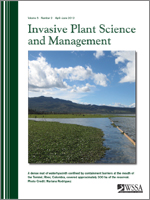Data on 111 environmental weed eradication programs carried out by the New Zealand Department of Conservation (DOC) have been collected and summarized. A total of 21 programs were discontinued, and 90 are ongoing. Within the ongoing programs, four have been successful in that no plants remain at any known infestations. All four of the successful eradications had a total area across all infestations of less than 1 ha (2.5 ac); however, many similar-sized programs were not successful. Correctly assessing the extent of infestations appears to be a major problem for discontinued programs. Some of the ongoing programs are progressing toward eradication, but this is taking much longer than initially anticipated. The strongest determinant of progress toward eradication was found to be the identity of the DOC administrative area, for reasons that are only speculative. The number and area of initial infestations had no effect on progress toward eradication. However, the rate at which new infestations were located was negatively correlated with progress. Across many programs, progress was restricted by inconsistent infestation visitation. After running for a decade, DOC's weed eradication strategy has yet to provide significant dividends. Environmental weed eradication is clearly more difficult than has previously been acknowledged in New Zealand.
Management Implications: This work summarizes a decade of plant eradication attempts by the New Zealand Department of Conservation. Data on 111 environmental weed eradication programs have been collected and summarized. A total of 21 programs were discontinued and 90 are ongoing. Within the ongoing programs, four have been successful in that no plants remain at any known infestations. All four of the successful eradications had a total area across all infestations of less than 1 ha; however, many similar-sized programs were not successful. Incorrectly assessing the extent of infestations appears to be a major contributing factor in discontinued programs. This highlights the importance of exhaustive delimitation surveys when initiating eradication programs.
Some of the ongoing programs are progressing toward eradication, but that is taking much longer than initially anticipated. The strongest determinant of progress toward eradication was found to be the identity of the administrative Area responsible for running the program. I speculate that some Areas do a better job of starting programs that are more likely to succeed, completing searches and control actions more thoroughly, and recording their data. The number and area of initial infestations had no effect on progress toward eradication, but the number of new infestations found through the course of eradication programs negatively affects progress. Clearing infestations is fundamentally required for eradication; there are likely to be many practical options available to increase the clearance rate of infestations for particular species, e.g., spending longer at each infestation or visiting twice during the growing season. Across many programs, progress was restricted by inconsistent infestation visitation.
After running for a decade, DOC's weed eradication strategy has yet to provide significant dividends. There are few publications that document all eradication efforts, so the success rate of plant eradications is impossible to accurately assess. Environmental weed eradication is clearly more difficult than has previously been acknowledged in New Zealand. It seems likely that too many programs have been undertaken. Better success may have been realized with fewer programs, tighter controls on program starting, and better coordination.





